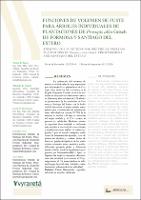Funciones de volumen de fuste para árboles individuales de plantaciones de Prosopis Alba Griseb. de Formosa y Santiago del Estero
Stem volume functions for individual trees on plantations of Prosopis Alba Griseb. FROM Formosa and Santiago del Estero
Date
2020-12-02Author
Pérez, Víctor R.
Castro, Marcelo R.
Rodríguez, Carla D.
Arce, Leandro
Mitre, José
Metadata
Show full item recordAbstract
La estimación del volumen de madera a nivel de árbol es muy importante para el manejo de las plantaciones de Prosopis alba, cada vez más relevantes en la Región Chaqueña. Usando técnica de medición no destructiva se obtuvieron valores de diámetro y altura de fuste de 555 árboles de plantaciones de las provincias de Formosa y Santiago del Estero, con la finalidad de determinar el mejor modelo matemático para la estimación del volumen de fuste individual con corteza. El 75% de la muestra se destinó a la fase de selección del mejor modelo y el 25% restante al proceso de validación. Mediante técnica de regresión lineal múltiple se evaluaron diez modelos a través de diversos criterios y estadísticos como análisis de varianza y prueba F para el modelo completo, coeficiente de determinación ajustado, error de estimación absoluto y relativo, índice de Furnival, prueba de hipótesis de los coeficientes estimados, error cuadrático medio, diferencia agregada global y diferencia media. Con los modelos logarítmicos propuestos por Schumacher-Hall y Spurr se lograron las mejores respuestas, obteniéndose alta exactitud (error menor al 5%) y sesgo menor al 1%, aconsejándose su utilización para la predicción confiable y satisfactoria del volumen de fuste individual. Wood volume estimation at tree level is very important for the management of Prosopis alba plantations, increasingly relevant in the Chaco Region. Using non-destructive measurement technique, values of diameter and stem height of 555 trees from forestations in Formosa and Santiago del Estero provinces were obtained, in order to determine the best mathematical model to estimate the volume of individual stem with bark. 75% of the sample went to the selection phase of the best model and the remaining 25% to the validation process. Using multiple linear regression technique, ten models were evaluated by various criteria and statistics such as analysis of variance and F test for the complete model, adjusted coefficient of determination, absolute and relative estimation error, Furnival index, hypothesis test of the estimated coefficients, mean squared error, global aggregate difference, and mean difference. With the logarithmic models proposed by Schumacher-Hall and Spurr, the best responses were achieved, obtaining high accuracy (error less than 5%) and bias less than 1%, advising their use for the reliable and satisfactory prediction of individual stem volume.
Collections
- Revista Yvyraretá [360]
The following license files are associated with this item:



